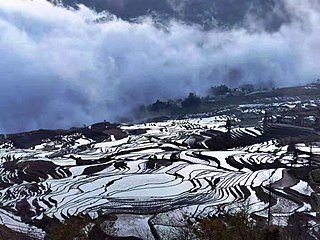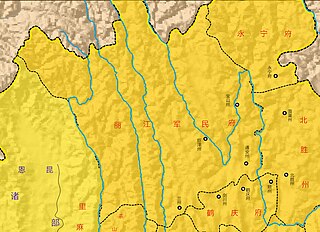
Yunnan, is a landlocked province in Southwest China. The province spans approximately 394,000 km2 (152,000 sq mi) and has a population of 48.3 million. The capital of the province is Kunming. The province borders the Chinese provinces of Guizhou, Sichuan, autonomous regions of Guangxi and Tibet, as well as Southeast Asian countries Vietnam, Laos, and Myanmar. Yunnan is China's fourth least developed province based on disposable income per capita in 2014.

The music of China consists of many distinct traditions, often specifically originating with one of the country's various ethnic groups. It is produced within and without the country, involving either people of Chinese origin, the use of traditional Chinese instruments, Chinese music theory, or the languages of China. It includes traditional classical forms and indigenous folk music, as well as recorded popular music and forms inspired by Western culture.

The Nakhi or Nashi are a people inhabiting the Hengduan Mountains abutting the Eastern Himalayas in the northwestern part of Yunnan Province, as well as the southwestern part of Sichuan Province in China.

Dali City is the county-level seat of the Dali Bai Autonomous Prefecture in northwestern Yunnan. Dali City is administered through 12 township-level districts, two of which are also commonly referred to as Dali.

Lijiang, formerly romanized as Likiang, is a prefecture-level city in the northwest of Yunnan Province, China. It has an area of 21,219 square kilometres (8,193 sq mi) and had a population of 1,253,878 at the 2020 census whom 288,787 lived in the built-up area (metro) made of Gucheng District. Lijiang is famous for its UNESCO Heritage Site, the Old Town of Lijiang, which contains a mixture of different historical architecture styles and a complex, ancient water-supply system.

Joseph Francis Charles Rock was an Austrian-American botanist, explorer, geographer, linguist, ethnographer and photographer.
Baisha xiyue is one of the two surviving forms of traditional music of the Nakhi people of Lijiang, Yunnan Province, China, known as "Nakhi ancient music". Baisha is a town located ten kilometres north of Lijiang, and was the capital of the independent Nakhi kingdom before it was annexed by the Yuan Empire in 1271.

Jade Dragon Snow Mountain is a mountain massif or small mountain range in Yulong Naxi Autonomous County, Lijiang, in Yunnan province, China. Its highest peak is named Shanzidou or Shan-Tzu-tou (扇子陡) and it is 5,596 m (18,360 ft) above sea level.
Naxi, also known as Nakhi, Nasi, Lomi, Moso, Mo-su, is a Sino-Tibetan language or group of languages spoken by some 310,000 people, most of whom live in or around Lijiang City Yulong Naxi Autonomous County of the province of Yunnan, China. Nakhi is also the ethnic group that speaks it, although in detail, officially defined ethnicity and linguistic reality do not coincide neatly: there are speakers of Naxi who are not registered as "Naxi" and citizens who are officially "Naxi" but do not speak it.

Autonomous prefectures are one type of autonomous administrative divisions of China, existing at the prefectural level, with either ethnic minorities forming over 50% of the population or being the historic home of significant minorities. Autonomous prefectures are mostly majority Han Chinese by population. The official name of an autonomous prefecture includes the most significant minority in that region, sometimes two, rarely three. For example, a Kazakh prefecture may be called Kazak Zizhizhou. Like all other prefectural level divisions, autonomous prefectures are divided into county level divisions. There is one exception: Ili Kazak Autonomous Prefecture contains two prefectures of its own. Under the Constitution of the People's Republic of China, autonomous prefectures cannot be abolished.

Chuxiong City is a county-level city and the capital of the Chuxiong Yi Autonomous Prefecture, in Central Yunnan Province, China.

Dongjing music or donjiang is a type of Chinese ritual music traditionally performed by the Nakhi people, Han people, and Bai people of Yunnan province in southwest China.

The gourd mouth organ is a free reed mouth organ played across East and Southeast Asia. It consists of a gourd wind chest with several bamboo or bronze pipes inserted on top of it, the numbers of pipes differing from region to region.

Dayan, commonly called the Old Town of Lijiang is the historical center of Lijiang City, in Yunnan, China. It is a UNESCO World Heritage Site.
Dongba Culture Museum is a museum in Lijiang City, Yunnan, China which deals with the Dongba culture of the Naxi (Nakhi) people.

Yulong Naxi Autonomous County is a county located in the northwest of Yunnan Province, China, bordering Sichuan Province to the northeast. It is the westernmost county-level division of the prefecture-level city of Lijiang. Wenhai village and lake along with Jade Dragon Snow Mountain are some of the famous scenic spots found here.
A qupai is the generic term for a fixed melody used in traditional Chinese music. The literal meaning is "named tune," "labeled melody," "titled tune," or "titled song". Qupai are relatively brief, most comprising between 20 and 70 measures in 2/4 meter. Many qupai are centuries old, but only a few of these have been handed down to the present.

The Chiefdom of Lijiang was a Nakhi autonomous Tusi chiefdom that ruled Lijiang during Yuan, Ming and Qing dynasty.
Chiefdom of Yongning was a Mosuo autonomous Tusi chiefdom during the Ming and Qing dynasties. The chiefdom was located at present-day Ninglang Yi Autonomous County at the convergence of Yunnan, Sichuan and Tibet.
















